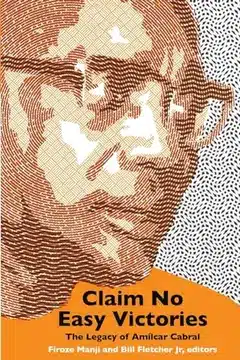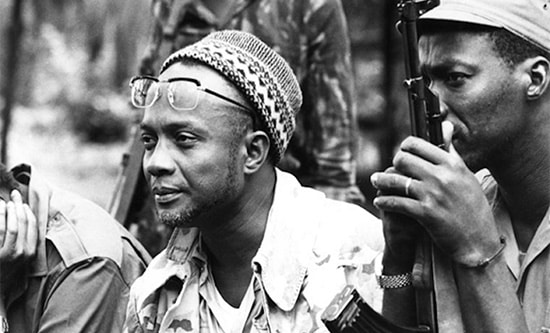Claim no easy victories: the legacy of Amilcar Cabral, Firoze Manji and Bill Fletcher Jr (eds), 2nd edition, Common Notions 2024, 384pp, $22

A hundred years since the birth of Cape Verde and Guinea-Bissau revolutionary Amilcar Cabral, and 50 years since his assassination, the second edition of Claim no easy victories: the legacy of Amilcar Cabral was published in January 2024. The collection assembled by Firoze Manji and Bill Fletcher Jr contains essays on his legacy. Cabral was a Marxist revolutionary and one of the main leaders against Portuguese colonialism which had plagued Africa since the 15th Century. Portugal’s dictatorship, which lasted from 1926 to 1974, maintained Portuguese colonial rule of Angola, Mozambique, Guinea, São Tomé and Príncipe, Cape Verde and Guinea-Bissau. Under Portuguese imperialism, Africans were subject to slave labour and apartheid, 99% were illiterate and there were no universities, they had no political rights and infant mortality was 40%. Cabral, along with other leaders, orchestrated a fierce and tactical style of guerrilla warfare across the lusophone (Portuguese-speaking) regions of Africa which lasted 13 years from 1961, overstretching and isolating the increasingly unpopular Portuguese dictatorship. This struggle resulted in its overthrow in the 1974 Carnation Revolution, a year after Cabral’s death, and the Portuguese colonies achieved independence.
Cabral’s legacy
The book’s introduction asserts the importance of Cabral’s theory and work today, however it’s not until the fifth essay that we are introduced to Cabral’s early life and Guinea-Bissau’s history. By colonial standards, Cabral was afforded a middle-class upbringing. He studied agronomy at Lisbon University, meeting Angolan and Mozambique students whose fellow countries were under Portuguese colonial rule. The ‘Cape Verdeanness’ literary renaissance, inspired by the Harlem Renaissance and Negritude Movement, strongly influenced Cabral. Though focused on rebuilding national identity, it was escapist and ‘did not in any way promote anticolonial consciousness or decolonisation’ (p106). Reiland Rabaka argues that ‘Marxism rather than neorealism provided Cabral’s theoretical framework’ (p106) in conjunction with this movement.
Independence movement
In 1956 Cabral founded the African Party for the Independence of Guinea-Bissau and Cape Verde (PAIGC). The brutal Pidjiguiti massacre in 1959, which killed 50 striking workers, convinced Cabral that a protracted armed struggle was the only way forward. ‘The colonial enemy would be worn down and vanquished by a thousand stings’ (p91). The PAIGC was joined by the MPLA (Angola), FRELIMO (Mozambique) and MLSTP (Sao Tome and Principe) in a joint coalition on 18 April 1961. Richard Lobban, who travelled with PAIGC, details their strategy of creating rural, hard-to-reach liberated zones, and the importance of military supplies from the socialist bloc. In less than ten years 75% of the countryside was liberated. Liberated zones had participatory democracy, public schools and hospitals, political education, recognition of female equality and soldiers working and learning alongside civilians. ‘In these territories, the party developed the beginnings of a revolutionary state’ (p334).
Political development
Cabral delivered his seminal address ‘The Weapon of Theory’ at the Tricontinental Conference hosted by Cuba in 1966 – a gathering of countries focused on existing anti-colonial and anti-imperialist struggles. He outlined the necessity of an armed struggle, the impact of imperialism and the role of the petit bourgeoisie in colonial and neo-colonial societies. Helmi Sharawy notes that ‘Imperial capital never contributed to the development of productive forces’ in the colonies (p144) and that Cabral acknowledges imperialism as a historical necessity and the final stage of capitalism. Thus national liberation was a historical necessity, the next stage would smash capitalism and bring about socialism. Adrian Harewood’s essay summarises that for Cabral ‘National revolution was but the first step’ and ‘National liberation was truly about wresting control of the productive forces of society’ (p207).
Cabral was convinced that a ‘return to the source’ was necessary, that Africans must reject the culture imported by Western imperialists and build a ‘national culture through struggle’. This was also important in winning over the petit bourgeoisie, a privileged social stratum with nationalist, pro-colonial and neutral wings, the majority being the latter. Maria Poblet in her essay notes how Cabral identified that the nationalist petit bourgeoisie could be a catalyst for revolutionary consciousness, due to their ‘higher level of education and political awareness’ (p213) and direct humiliation from colonial agents. In Cabral’s vision, a national revolution centred around forging a national culture to free itself from an imposed foreign one could sway the petit bourgeoisie to the peasants, forming a mass struggle and having them commit ‘class suicide’ – completely identifying with their people and their aspirations rather than the imperialists. They would thus play an important role in ousting the ‘pseudo-bourgeoisie’ – Cabral’s term for the comprador capitalist class installed by the colonial regime – and assume their duties after the revolution.
Cabral asserted that National Liberation occurs when people reassume their capacity for history-making concretely, when the productive forces are liberated; only then could a new culture and new nation based on proud African heritage be built. ‘Unity for us to struggle against the colonialists and struggle for us to achieve unity, to construct the land as it should be’. In this dialectical struggle for unity, the ‘central threat to building a new society based on mass participation was internal’ (p36). Cabral spoke about the ‘cancer of betrayal’ that plagues national liberation movements after independence and pondered to what extent it was linked to the class struggle and existing structures. Quoted in Nigel Gibson’s essay, Cabral recognises that the main internal contradictions rest within the petit-bourgeoisie. He says, ‘If I am ever murdered it will be from within our own ranks. No one from outside can destroy the PAIGC, it will take one of our own to do it.’ Less than a year later on 20 January 1973, Cabral too was assassinated by two PAIGC security guards, suspected to have been collaborating with the Portuguese secret police. Just one year after his death the last Portuguese soldiers left Guinea-Bissau on 15 October 1974, bringing an end to Portuguese colonialism in Africa and Portugal’s fascist regime.
Cabral’s influence cannot be overstated; his analysis saw colonialism as a complex shapeshifter and therefore culture as a ‘malleable force for national consciousness and nation building’ can be used today in ‘resolving crises in ideology, in addressing atomised partisanship and in tackling conflicts festered by identity politics, race, and warring cultures’ (p137). As the spokesperson for the PAIGC, MPLA and CONCP he was the architect of the destruction of Portuguese imperialism. He also revolutionised the agricultural landscape of Guinea-Bissau, making farmers the beneficiaries, modernising techniques and diversifying crop production. Many of his techniques are still used to cultivate the lands. Cabral reminded us that it’s not just the class struggle that is a driving force of history but everything that came before that, the history before the formation of classes and before Africa’s contact with imperialism. The variety of Cabral’s significant contributions to Marxism and anti-colonial praxis is evident throughout this book.
Women and emancipation
Cabral believed we should ‘shoot the body and not the shadow’; to combat the material realities that produce different forms of oppression rather than waste effort combating the people. He applied this not only to racism but also to the issue of women’s rights and emancipation from patriarchy. In his words ‘We are fighting two colonialisms, one of the Portuguese, the other of men’. In his titular address to the party ‘Tell no lies, claim no easy victories’, he actively called on his party cadres and the working class to ‘fight twice’, once to convince the women and twice to convince the men that women must have the same rights. This address also criticised those in the revolution who displayed reactionary and liberal behaviour and outlined a progressive political character for the liberation movement. Cabral pushed for women in high-ranking posts at every level, encouraging them to play an active role in the revolution and the armed struggle, shattering the Portuguese-imposed capitalistic gender roles. Many women had been transformed from subservient maids to powerful revolutionaries by their will and desire to change their conditions. After his death, the women’s organisations dwindled and became mouthpieces for the party, with previous leaders now reduced to lesser non-political roles tied to traditional gender norms. However, women today actively participate in the government and continue to battle the patriarchy such as in 2011 when there were major victories against the practice of female genital mutilation. The authors say they hoped to have more essays in this section and refer to it as ‘especially important’ but do not elaborate why. This is disappointing, given that, to quote Thomas Sankara, ‘There is no true social revolution without the liberation of women.’
Cabral, Rodney and Fanon
For Cabral, Pan-Africanism was rooted in the revolutionary struggle of African peoples and diaspora against oppression everywhere. In her essay, Patricia Rodney draws interesting parallels between her husband Walter Rodney’s life and Cabral’s, ‘martyred sons of Africa in the arduous yet unfinished struggle to liberate all Africans and all colonised peoples from foreign domination’ (p251). They both saw Marxism as a tool for ‘interpreting and overcoming neocolonialism’ (p252) and an analytical weapon in the struggle for freedom. They knew that preserving the structures of colonialism but replacing the white leaders with black compradors would achieve very little. Frantz Fanon also understood the necessity of linking Marxist and anti-colonial theory with the armed struggle against the occupying colonisers and the national bourgeoisie, preparing them to commit class suicide and help lead the revolution. Cabral, Fanon and Rodney generally saw tribal and ethnic contradictions as subordinate to class contradiction.
Cabral saw the African American struggle in the US as intrinsically tied to the African struggle. In Guinea-Bissau, they were not fighting Portuguese people but the system of colonialism and so for Cabral, African Americans should combat the actual cause of racism, US imperialism. For the black left such as the Black Panther Party in the US who had been forcibly divorced from their roots due to slavery and under the boot of white supremacy, it is no surprise that Cabral’s ‘returning to history’ ideology resonated with them the most, reminding them it’s not only a struggle for their rights but also for rediscovering their cultural identity, history and place on this planet, including their connection to the wider African diaspora. ‘To our colonisers, our music was noise, our dance was obscenity, our religion was fetish, we did not have literature, philosophy was beyond our ken, and, most of all, we were a people without history’ (p294). Today in Guinea-Bissau, rap artists often reference ‘Cabral ka muri/mori’ meaning ‘Cabral is not dead’, immortalising his ideas (p319).
Wider struggle and implication for today
Today the traditional comprador elite that Cabral warned against in Guinea-Bissau is in full power and is keen to erase the history of previous anti-colonial struggles. The petit bourgeoisie continue to sell themselves to the interests of Western multinational companies and NGOs. State education has been abandoned and many of this newer generation have been divorced from their history, roots and teaching of Amilcar Cabral. Yet Cabral’s ideas have never been so relevant as Africa continues its post-colonial stage with signs of new leaders who can potentially drive significant social and political progress in overcoming this neocolonial period. With these essays, Manji and Fletcher Jr make an irrefutable case for why Cabral’s legacy is something we must keep alive, not just in our minds but also in our work towards building socialism. A luta continua!
Cassius J Kalany
FIGHT RACISM! FIGHT IMPERIALISM! 301 August/September 2024




